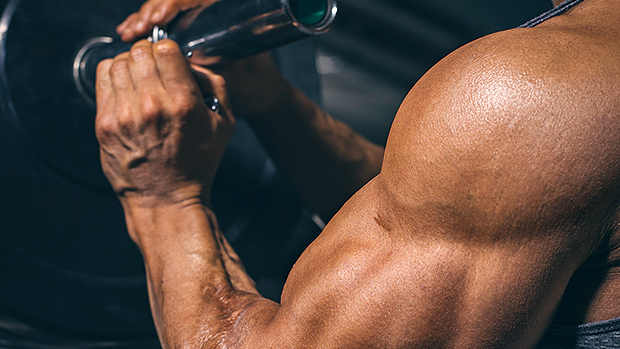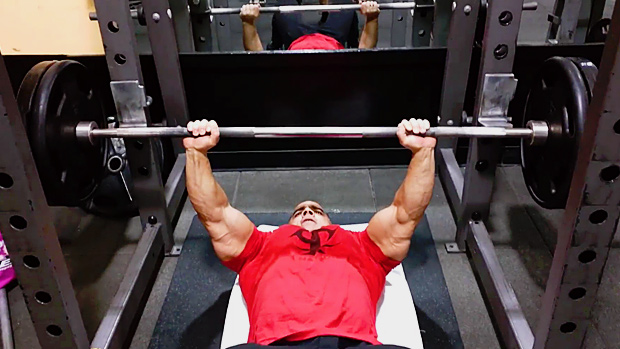Exercises vs. Methods
Newbies only think about exercises. Advanced lifters think more about methods, techniques, and principles. A rep is not a rep. A set is not a set. How is the rep performed? How is the set arranged? How is the weight manipulated? What's the lifting speed and contraction method?
The answers can be the difference between making gains and stalling out. Think beyond exercises and reignite your progress. Try these training methods.

To keep making progress, you have to keep your body challenged in a way that forces it to adapt by getting bigger or stronger. To do this, the average person in the gym will change exercises or just try adding more weight to the bar. Both methods have their place, but there are other tools available too, like this one.
When most people think of sets and reps, they think "3 sets of 10 reps" or something close to that. Try this instead: Hit a certain number of TOTAL reps for the exercise, like 40. That's not 40 reps per set, but 40 total reps for a particular exercise, no matter how many sets it takes. In fact, forget about counting sets.
The first thing to do is choose a weight to use on an exercise. To do that, find your 8-rep max. That's the weight you'll use for the whole exercise. If you can get over 8 reps on the first set, it's too light. If you can't get 8 reps on the first set, it's too heavy. Easy enough?
With your weight selected, you'll now shoot for 40 total reps for the exercise, regardless of how many sets it takes. You'll use the same weight all the way through. Don't even count sets, only reps. As you fatigue, you won't be able to get the same number of reps per round, and that's fine because we're only concerned with total reps. Here's an example:
Exercise: Cable Triceps Pressdown
- Reps: 40 total
- Weight: 8RM on first set
- Sets: It doesn't matter, remember?
- Rest: About 45 seconds between sets
Example:
- Set 1: 8 reps
- Set 2: 8 reps
- Set 3: 6 reps
- Set 4: 5 reps
- Set 5: 4 reps
- Set 6: 4 reps
- Set 7: 3 reps
- Set 8: 2 reps
- Total reps: 40
Compare that to 3x10. You've completed MORE reps using a HEAVIER weight.
Remember: The above is just an example. You may be able to finish off all 40 reps in 6 or 7 sets. Or it could take you 10 sets where you're down to doing single reps at the end. It all works as long as you're following the weight and rest rules.
Now, you're only resting 45 seconds between sets and you're starting with your 8RM, so every set will be taken to failure. If you can get 8 reps on every set, then you either started too light or you rested way longer than 45 seconds between sets. Make sure you're using a true 8RM on that first set and follow the rest period guideline.
Chad Waterbury popularized this method here on T Nation and it's the foundational workout of our Velocity Diet program. Download the free ebook for a complete training program using this method: The Velocity Plan

Coach Florian Bianchi is known for training athletes and bodybuilders who dominate in the leg department. He shared one of his "tricks" with Christian Thibaudeau who introduced it to T Nation:
Start every workout with 100 reps on the leg press. And not just on leg day; do it every single workout, even chest day.
Use a very light weight. You might need to start with the empty sled. Try to get all 100 reps unbroken (without racking the sled). Use a moderate speed and tempo. Don't go slow, but don't go super fast either. Rhythmic reps is what we want. You can take pauses, but ideally these would be done without racking the weight. Just pause at the top on locked legs.
Basically this acts as your warm-up for every single training session you do. You can gradually add weight, but going heavy for 100 reps isn't the goal. The goal is to just get the blood flow going and get pumped. If you do this your legs will completely change their look in a few weeks, and it only takes a couple of minutes per workout.
How's It Work?
Over time this increases the number of capillaries going to your legs: your lower body will become more "vascularized" and it'll become easier to shuttle nutrients and amino acids to these muscles. This facilitates recovery and muscle growth.
It'll also help you recover faster during your lower body workouts because more capillaries equal more blood flow. More blood flow results in more oxygen to the muscles and more efficient clearing of lactic acid between sets.
For women, this is also great for fat loss. Women tend to have less lower body vascularization and less efficient blood flow to their lower bodies. This is one of the reasons why it's harder for them to get a super-lean lower body. More vascularization makes it easier to mobilize fat in the region, which is the first step in getting leaner.
Doing these high-rep leg presses daily will help solve that issue. It does take some time to build up these new capillaries, but once the adaptations have taken place it'll make it easier for you to get lean legs.
Bonus benefit: Just the fact that you're using your legs more often will make you better at recruiting the muscles. This will facilitate stimulation during your heavy work.

"If you want to build your biceps, you must improve your ability to recruit and contract them," says Coach Thibaudeau.
And when it comes to biceps, focusing on getting them strong often makes it more difficult to get them big. Going heavy can shift the tension away from the biceps. Practicing intense contraction of the target muscle is much harder to do when using heavy weights.
So when you're trying to fix lagging biceps, the first thing to do is work on constant tension to maximize the mind-muscle connection. The time spent doing it will be an investment in all the future biceps training you'll do.
Do every rep of your bicep work like this for 4 weeks:
- Before even lifting the weights, tense the biceps as hard as you can, as if you were trying to flex. That is the "principle of first tension" – the muscle firing hardest FIRST is the one that'll receive the most stimulation during the set.
- Then when you lift and lower the weight, use a slower tempo. About 3 seconds up and down.
This allows you to tense the biceps as hard as possible during every inch of every rep. If you go faster it's harder to keep the muscle maximally tensed. During the lowering portion you should actually flex and tense your triceps too.
The Benefits
This is the best way to become really good at recruiting and contracting the biceps and you'll program your nervous system to do it, which will make the future heavier biceps work more effective.
It stimulates muscle growth via an accumulation of growth factors and mTOR activation, but there's very little, if any, muscle damage. So you can (and should) do this type of biceps work multiple times during the week: 3-4 days a week.
Remember, frequency of practice is the key to motor learning. Once you've spent some time training the biceps like this, you'll be able to switch to heavy lifting, but now the tension won't shift away from the biceps because you improved your capacity to recruit the muscle and keep it tensed.

One way to get muscles to really grow is to tap into those stubborn Type II muscle fibers. The problem? You need to totally exhaust your Type I muscle fibers first. Only then can you "reach" the Type II's.
The second problem? Most people never reach them and their muscle growth stagnates.
Here's what to do: Before you begin your regular working sets, do a super-light set to failure first. How light? About 20 percent of your 1RM. What this does is fatigue the Type 1 fibers enough to open the door to accessing Type II fibers. Result? More strength and size gains.
Example: Biceps Curl
Just to keep the math simple, let's say your 1 RM on the biceps curl is 100 pounds. Twenty percent of that is 20 pounds.
- Before starting your regular sets of curls, rep out with the 20 pound bar. Go to failure. This isn't a warm-up; it's a ball-busting high-rep set performed until you can't lift it for one more rep.
- Rest 30 seconds.
- Now grab your regular working weight, which is probably around 75 pounds (since your 1RM is 100 pounds). Do your regularly planned sets, resting about 60 seconds between sets.
Based on some studies done on this method, you'll get greater strength and hypertrophy gains.
This is another gem from Christian Thibaudeau. Here's how it works:
- Start an exercise by doing a full range of motion. Do reps until you're close to hitting failure, then...
- Cut the range of motion in half and do partial reps. When you feel that you're about to hit failure in that partial range....
- Cut the range of motion in half again (do quarter reps) until you finally hit total failure. Depending on the exercise, the partials will be done in either the top portion or bottom portion.
For Size Gains
Use a weight you can lift for 8-10 full reps before reverting to half and then quarter reps.
For Size and Strength Gains
Use a weight you can lift for 4-6 full reps before reverting to partial reps. This method allows you to use a decent amount of weight.
Examples
- Squat: Full reps, then upper-half reps, then quarter reps
- Hamstring Curl: Full reps, then lower half reps, then quarter reps
- Biceps Cable Curl: Full reps, then lower half reps, then quarter reps
- Leg Press: Full reps, then upper half reps, then quarter reps
- Lateral Raise: Full reps, then lower half reps, then quarter reps
- Bench Press: Full reps, then upper half reps if you want to focus on delts and triceps. If you want to focus more on the chest, do quarter reps in the lower half of the movement.

Okay, this one isn't "new" but it's probably new to you. Old-school bodybuilding coach Vince Gironda called this the "Mr. Olympia routine" because it was the one he used to train Larry Scott, the first Mr. Olympia.
The idea is to do a lot of work in very little time, what we now call "high density training." Here's how to do it:
- Choose an exercise.
- Load the bar with a weight you can lift 10 times.
- Don't lift it 10 times. Instead, do 6 reps.
- Rest for 30 seconds and repeat 5 more times.
- In other words: 6 x 6 with 70% of your 1RM with only 30 seconds rest between sets.
Gironda even had his advanced bodybuilders resting only 15 seconds between sets, but start with 30. Remember, the key here is density, not load. If you can't do all 6 sets with a strict 30 seconds rest, reduce the weight until you adapt to the short rest periods.
- Aguiar AF et al. A single set of exhaustive exercise before resistance training improves muscular performance in young men. Eur J Appl Physiol
. 2015 Jul;115(7):1589-99.





